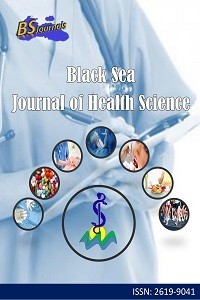Periapical Healing of Mandibular Posteriors Having Calcific-Like Deposits: A Rare Case Report
Apical periodontitis, Calcific-like deposits, Pulp necrosis, Radiolucent lesion
Periapical Healing of Mandibular Posteriors Having Calcific-Like Deposits: A Rare Case Report
___
- Byström A, Claesson R, Sundqvist G. 1985. The antibacterial effect of camphorated paramonochlorophenol, camphorated phenol and calcium hydroxide in the treatment of infected root canals. Dental Traumatol, 1(5): 170-175.
- Carranza F. 1990. The role of calculus in the etiology of periodontal disease. Clickman’s Clinical Periodontology. WB Saunders, Philadelphia, US, pp: 394-395.
- Consolaro A, Consolaro RB, Francischone LA. 2012. Cementum, apical morphology and hypercementosis: a probable adaptive response of the periodontal support tissues and potential orthodontic implications. Dental Press J Orthodont, 17(1): 21-30.
- Grahnen H. 1961. The prognosis of pulp and root canal therapy a clinical and radiograhic follow-up examination. Odontol Rev, 12: 146-165.
- Harn WM, Chen YHM, Yuan K, Chung CH, Huang PH. 1998. Calculus‐like deposit at apex of tooth with refractory apical periodontitis. Dental Traumatol, 14(5): 237-240.
- Hinrichs J. 2006. The role of dental calculus and other predisposing factors. URL: https://pocketdentistry.com/7-the-role-of-dental-calculus-and-other-local-predisposing-factors/ (access date: December 12, 2022).
- Horner K, Rout J, Rushton VE. Interpreting dental radiographs. Quintessence Publishing Company Limited, London, UK, pp: 156.
- Kumar SG. 2015. Orban's Oral Histology & Embryology. Elsevier, New Delhi, India, pp: 458.
- Langlais RP, Langland OE, Nortjé CJ. 1995. Diagnostic imaging of the jaws. Williams & Wilkinsons, Baltimore, MD, US.
- Lomçali G, Şen B, Cankaya H. 1996. Scanning electron microscopic observations of apical root surfaces of teeth with apical periodontitis. Dental Traumatol, 12(2): 70-76.
- Lorello O, Foster DL, Levine DG, Boyle A, Engiles J, Orsini JA. 2016. Clinical treatment and prognosis of equine odontoclastic tooth resorption and hypercementosis. Equine Vet J, 48(2): 188-194.
- Nair P. 2006. On the causes of persistent apical periodontitis: a review. Int Endodont J, 39(4): 249-281.
- Nair PR, Sjögren U, Krey G, Kahnberg KE, Sundqvist G. 1990. Intraradicular bacteria and fungi in root-filled, asymptomatic human teeth with therapy-resistant periapical lesions: a long-term light and electron microscopic follow-up study. J Endodont, 16(12): 580-588.
- Noiri Y, Ehara A, Kawahara T, Takemura N, Ebisu S. 2002. Participation of bacterial biofilms in refractory and chronic periapical periodontitis. J Endodont, 28(10): 679-683.
- Pappen FG, Cecilia DF, Josué M, Silveira M, Fernando L. 2011. Hypercementosis: a challenge for endodontic therapy. Revista Sul-Brasileira de Odontologia, 8(3): 321-328.
- Park E, Shen Y, Haapasalo M. 2012. Irrigation of the apical root canal. Endodon Topics, 27(1): 54-73.
- Prabhakar A, Reddy SVV, Bassappa N. 1998. Duplication and dilaceration of a crown with hypercementosis of the root following trauma: A case report. Pediatric Dent, 29(10): 655-657.
- Raghavan V, Singh C. 2015. Hypercementosis: review of literature and report of a case of mammoth, dumbbell-shaped hypercementosis. J Indian Acad Oral Medic Radiol, 27(1): 160.
- Ricucci D, Candeiro GTM, Bugea C, Siqueira JF. 2016. Complex apical intraradicular infection and extraradicular mineralized biofilms as the cause of wet canals and treatment failure: report of 2 cases. J Endodont, 42(3): 509-515.
- Ricucci D, Martorano M, Bate AL, Pascon EA. 2005. Calculus‐like deposit on the apical external root surface of teeth with post‐treatment apical periodontitis: report of two cases. Int Endodont J, 38(4): 262-271.
- Ricucci D, Siqueira JF. 2010. Biofilms and apical periodontitis: study of prevalence and association with clinical and histopathologic findings. J Endodont, 36(8): 1277-1288.
- Rud J, Andreasen J. 1972. A study of failures after endodontic surgery by radiographic, histologic and stereomicroscopic methods. Int J Oral Surg, 1(6): 311-328.
- Song M, Kim HC, Lee W, Kim E. 2011. Analysis of the cause of failure in nonsurgical endodontic treatment by microscopic inspection during endodontic microsurgery. J Endodont, 37(11): 1516-1519.
- Spoque J. 1973. Oral pathology. CV Mosby, St. Louis, US, pp: 134.
- Streckfuss JL, Smith WN, Brown LR, Campbell MM. 1974. Calcification of selected strains of Streptococcus mutans and Streptococcus sanguis. J Bacteriol, 20(1): 502-506.
- Sundqvist G, Figdor D, person S. 1998. Microbiologic analysis of teeth with failed endodontic treatment and the outcome of conservative re-treatment. Oral Surg Oral Medic Oral Pathol Oral Radiol Endodontol, 85(1): 86-93.
- Sundqvist G. 1976. Bacteriological studies of necrotic dental pulps. Umeå University, Odontological Dissertations, Umea, Sweden, pp: 101.
- Yang CM, Hsieh YD, Yang SF. 2010. Refractory apical periodontitis associated with a calculus-like deposit at the root apex. J Dental Sci, 5(2): 109-113.
- Yayın Aralığı: Yılda 4 Sayı
- Başlangıç: 2018
- Yayıncı: Cem TIRINK
Effect of Covid-19 Vaccination on Hospitalizations
Emre ÖZGEN, Bahadır YAZICIOĞLU, Melek BİLGİN, Muhammet Ali ORUÇ
Hemşirelerin Tükenmişlik Düzeylerinin Duygusal Habitus Bağlamında İncelenmesi
Alev AKSOY, Çetin SEVÜK, Gülümser EVLİOĞLU
Serkan ZİNCİR, Pelin KARTAL, Aytül Gürsu HARİRİ
Sleep Quality and Associated Factors in Women
Hemşirelik Öğrencilerinin Yaşlılara Yönelik Tutumları: Pozitif ve Negatif Yaşlı Ayrımcılığı
Kamile KIRCA, Elif SOZERİ, Burcu BAYRAK KAHRAMAN
Periapical Healing of Mandibular Posteriors Having Calcific-Like Deposits: A Rare Case Report
Babak MOBARAKI, Aslan JAHANDİDEH, Sadık TAKİ, Can ÖZÜKOÇ, Onur ÇAPAR
Evaluation of Root Dilaceration and Taurodontism in Children with and without Cleft Lip and Palate
Melisa ÖÇBE, Büşra Dilara ALTUN, Mehmet Oğuz BORAHAN, Asım DUMLU
Experiences of Nursing Students in Practicing Blood Transfusion
